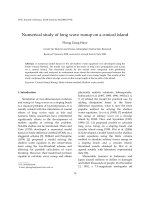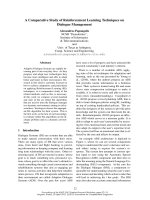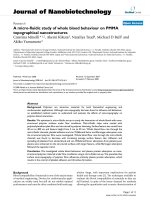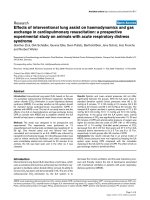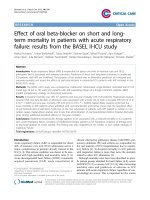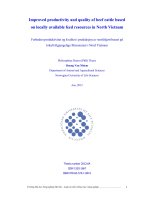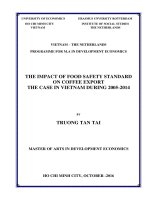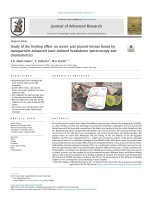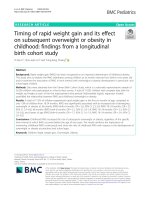A study of performance appraisal effect on employee performance: A case in curnon Vietnam
Bạn đang xem bản rút gọn của tài liệu. Xem và tải ngay bản đầy đủ của tài liệu tại đây (4.34 MB, 81 trang )
<span class="text_page_counter">Trang 1</span><div class="page_container" data-page="1">
<b>THE UNIVERSITY OF BOLTON </b>
<b>DISSERTATION </b>
BSc (Hons) Business Management Cohort 16
<b>A STUDY OF PERFORMANCE APPRAISAL EFFECT ON EMPLOYEE PERFORMANCE: A CASE IN CURNON VIETNAM </b>
<b> </b>
</div><span class="text_page_counter">Trang 2</span><div class="page_container" data-page="2">
<b>2.3 Performance Appraisal Feedback and Staff Performance ... 16 </b>
<b>2.4 Performance Appraisal Process and Staff Performance ... 17 </b>
<b>2.5 Performance Appraisal Goals and Staff Performance ... 18 </b>
<b>2.6 Performance Appraisal Methods and Staff Performance ... 19 </b>
</div><span class="text_page_counter">Trang 3</span><div class="page_container" data-page="3"><b>3.9 Data analysis and Presentation ... 25 </b>
<b>4.2.2 Demographic Data from the Respondents ... 29 </b>
<b>4.2.3 Performance Appraisal Feedback ... 35 </b>
<b>4.2.4 Performance Appraisal Process ... 39 </b>
<b>4.2.5 Performance Appraisal Goals ... 43 </b>
<b>4.2.6 Performance Appraisal Methods ... 48 </b>
<i><b>CHAPTER 5... 53 </b></i>
<i><b>CONCLUSION AND RECOMMENDATIONS ... 53 </b></i>
<b>5.1.1 Performance Appraisal Feedback and Employee Performance ... 53 </b>
<b> 5.1.2 Performance Appraisal Process and Employee Performance ... 54 </b>
<b>5.1.3 Performance Appraisal Goals and Employee Performance ... 55 </b>
<b>5.1.4 Performance Appraisal Methods and Employee Performance... 56 </b>
<b>5.2 Conclusion ... 57 </b>
<b>5.3 Recommendations ... 58 </b>
<i><b>APPENDICES ... 70 </b></i>
<b>APPENDIX I: LETTER OF INTRODUCTION (ENGLISH-VIETNAMESE) ... 70 </b>
<b>APPENDIX II: RESEARCH STUDY QUESTIONNAIRES (ENGLISH-VIETNAMESE) ... 72 </b>
<b>APPENDIX III: RESEARCH ETHICS CHECKLIST ... 77 </b>
</div><span class="text_page_counter">Trang 4</span><div class="page_container" data-page="4"><b>LIST OF TABLES </b>
<small>Table 3.1: Table displaying sample size ... 23 </small>
<small>Table 4.1: Table displaying Response Percentage ... 27 </small>
<small>Table 4.2: Table displaying g respondents’ gender ... 29 </small>
<small>Table 4.3: Table displaying Age Distribution of Respondents ... 29 </small>
<small>Table 4.4: Table displaying respondents’ highest level of education . ... 31 </small>
<small>Table 4.5: Respondents Job Designation ... 32 </small>
<small>Table 4.6: Table displaying Table showing years worked by respondents ... 33 </small>
<small>Table 4.7: Table displaying whether PA Feedbacks impact employee performance ... 34 </small>
<small>Table 4.8: Table displaying the extent to which Curnon’s staff performance is impacted by its PA Feedbacks ... 35 </small>
<small>Table 4.9: Table displaying responders' opinions on statements relating to Curnon 's PA Feedbacks ... 36 </small>
<small>Table 4.10: Table displaying whether PA Process impacts Employee Performance ... 38 </small>
<small>Table 4.11: Table displaying the extent to which Curnon's employee performance is impacted by its PA Process. ... 39 </small>
<small>Table 4.12: illustrating responders' opinions on statements relating to Curnon's PA Process ... 41 </small>
<small>Table 4.13: Table displaying whether PA Goals impact employee performance ... 44 </small>
<small>Table 4.14: Table displaying respondents’ opinion on statement that relate to performance appraisal goals at Curnon... ... 42 </small>
<small>Table 4.15: Table displaying responders' opinions on statements relating to Curnon's PA Goals. ... 45 </small>
<small>Table 4.16: Table displaying whether PA Methods impact employee performance... 47 </small>
<small>Table 4.17: Table displaying the extent to which Curnon’s staff performance is impacted by its PA Method ... 48 </small>
<small>Table 4.18: Table displaying responders' opinions on statements relating to Curnon's PA Methods ... 49 </small>
</div><span class="text_page_counter">Trang 5</span><div class="page_container" data-page="5"><b>LIST OF FIGURES </b>
<small>Figure 2.1: Diagram displaying tDiagram showing how independent </small>
<small>variables and dependent variables are related... ... 20 </small>
<small>Figure 4.1: Figure displaying Response Percentage... ... 28 </small>
<small>Figure 4.2: Chart displaying the respondent gender ... 29 </small>
<small>Figure 4.3: Figure displaying Respondents Age Distribution... ... 30 </small>
<small>Figure 4.4: Figure Highest Education Level of responders... ... 31 </small>
<small>Figure 4.5: Figure displaying Respondents Job Designation... ... 32 </small>
<small>Figure 4.6: Figure displaying Respondent Work Years ... 33 </small>
<small>Figure 4.7: Figure displaying if PA Feedbacks impact employee performance... ... 34 </small>
<small>Figure 4.8: Figure displaying the extent to which Curnon's staff performance is impacted by its PA Feedbacks... ... 35 </small>
<small>Figure 4.9: Figure displaying how employees at Curnon felt about statements related to their PA Feedbacks ... 37 </small>
<small>Figure 4.10: Figure displaying if PA Process impacts employee performance... ... 38 </small>
<small>Figure 4.11: Figure displaying the extent to which Curnon's employee performance is impacted by its PA Process... ... 40 </small>
<small>Figure 4.12: Figure displaying how employees at Curnon felt about statements related to their PA Process... ... 43 </small>
<small>Figure 4.13: Figure displaying demonstrating if PA Goals impact employee performance...41 </small>
<small>Figure 4.14: Figure displaying the extent which PA goals impact employee performance at Curnon... ... 44 </small>
<small>Figure 4.15: Figure displaying how employees at Curnon felt about statements related to their PA Goals .... 46 </small>
<small>Figure 4.16: Figure displayingwhether PA Methods impact employee performance... ... 47 </small>
<small>Figure 4.17: Figure displaying displayingthe extent to which Curnon’s staff performance is impacted by its PA Methods... ... 48 </small>
<small>Figure 4.18: Figure displaying displaying how employees at Curnon felt about statements related to their PA feedback. ... 50 </small>
<b>ACRONYMS AND ABBREVIATION </b>
<b>PA </b> : Performance Appraisal
<b>HR </b> : Human Resource
</div><span class="text_page_counter">Trang 6</span><div class="page_container" data-page="6"><b>ABSTRACT </b>
The purpose of this research sought to investigate the way performance appraisal feedback, process, goals, and methods impacts employee performance at Curnon Vietnam. The investigation will help businesses strengthen efficient performance evaluation methods by determining and creating instructions for bettering employees’ appraisal and performance. For academics and researchers, the investigation's outcomes will offer an in-depth review of the area and shape a foundation for future studies. Descriptive cross-sectional study was used. The research targeted 72 Curnon workers and sampled 60. The researcher pilot-tested questionnaires on 10 workers. The researcher used statistical techniques including mean, average, and percentage to draw conclusions. Data was analyzed using straightforward spreadsheet summaries and diagrams. Tables, charts, and graphs display data. Coding and organizing data into ideas allowed population generalization. The research found that performance assessment feedback is crucial because it allows firms to evaluate personnel against predetermined criteria and expectations. Performance evaluations and comments are crucial since they allow firms to assess worker performance against predetermined criteria and expectation. The questionnaire additionally discovered that performance assessment objectives are vital to job happiness, worker efficiency, outstanding performance, and personnel faith and dedication. The report suggests that Curnon Vietnam's leadership and human resources department clarify the evaluation's objective and educate personnel on giving and receiving feedback. Everyone from managers to workers ought to be engaged with performance appraisal structuring, and the performance assessment rules should be simple to access to every one of workers, and the business's performance evaluation procedure must become more open, transparent as well as sensible. Ultimately, Curnon's HR department ought to guarantee that performance appraisal goals have a good structure to allow them to recognize employees that need training so that could enhance the general productivity.
</div><span class="text_page_counter">Trang 7</span><div class="page_container" data-page="7"><b>DECLARATION </b>
By signing below, I attest that "A STUDY OF PERFORMANCE APPRAISAL EFFECT ON EMPLOYEE PERFORMANCE: A CASE IN CURNON VIETNAM" is my own work and has not been submitted to any other institution for credit toward a degree. I also declare that this document does not contain any material written or published by others, unless properly cited and the author appropriately acknowledged.
<b>Declared by: </b>
<b>Nguyen Hoang My ……… 1<sup>st</sup> May 2023 </b>
<b>Confirmed by: </b>
<b>Ms. Begum Asma ……… 1<sup>st</sup> May 2023 </b>
</div><span class="text_page_counter">Trang 8</span><div class="page_container" data-page="8"><b>CHAPTER 1 INTRODUCTION 1.1 Introduction </b>
To gain an increase in employee productivity, it is essential for companies to assess and communicate how well an employee is performing on the job. Performance appraisal is used in businesses as a technique for both assessment and improvement. When it comes to making important choices about pay, training, incentives, and promotions—all of which are critical to maintaining and increasing employee productivity—an objective and trustworthy performance review is essential (Zhang and Bartol, 2010). New recruits may be better placed, planned for, and counseled based on the results of a performance review. As a developing tool, it highlights workers with administrative qualities, who may be regarded as management materials, for greater leadership roles in the company. In this theoretical framework, it is shown that the feedback mechanism built into performance appraisals is a powerful motivator that leads to improved productivity (VandeWalle et al., 2000; Whitaker et al., 2007). The value of a highly engaged workforce has been noted by Pulakos (2009), where the author makes the point that the productivity of the workers is truly the productivity of the company. Employee motivation is boosted by performance reviews because they help employers meet workers' immediate needs while also creating an environment that presents them with constructive challenges. Job enhancement, in which the individual's work is reorganized to increase their sense of fulfillment in their role, is a common component of this approach.
The problem of management in a business is a particularly difficult one. According to Prasad (2005), one of the most important aspects of effective leadership of any company involves dealing with the efficiency of the workers via the use of high-quality performance review activities. This represents a change from the previously held view that boosting productivity in a company primarily involves pressuring its people to perform at their best without also considering their level of contentment in their jobs. Biswajeet (2009) made a valid point when the author stated that a company can achieve success if its staff's performance is properly assessed. This means that a performance scale ought to be implemented, with factors like employee motivation, customer satisfaction, efficient marketing tactics, profits,
</div><span class="text_page_counter">Trang 9</span><div class="page_container" data-page="9">and efficiency all being taken into account (Chan and Lynn,1991). These components make up the primary interaction that establishes how effectively a business does or will function in the future. Leisink and Knies (2017) believe that assessments aid management in improving, evaluating, and providing an objective foundation for HR choices; and assist employees understand the expectation from the business, which in turn strengthens and improves their performance (Lindsey, 2005; Longenecker, 1997; Waldersee and Luthans, 1994; Wells, 2002).
The performance assessment system is crucial to human resources management, but it's also highly vulnerable (Pulakos, 2009). Performance evaluation must link work needs to corporate objectives. According to Grubb (2007), measuring an employee's current performance and improving their future performance benefits the organization. Performance evaluation goals must be well understood and applied by evaluators. Wolf (2005).The method of judging employee performance must be sensitive enough to distinguish between top performers and slackers. It must be precise enough to guarantee that different raters using the same method will provide consistent results when applied to the same employee. Workers and reviewers must comprehend the method used to evaluate performance (Fletcher, 2004). Efficiency increases when employees know how well they're performing their work and share that information. Public and commercial companies utilize performance reviews to assess workers and management. After hiring, training, and working, Mathis and Jackson (1994) recommend performance evaluations. Thus, a performance assessment appraisal evaluates an employee's work and provides feedback and coaching to improve productivity.
<b>1.2 Curnon Vietnam Background information </b>
Many Vietnamese high-end watches are imported or made by foreign brands. Curnon, founded in 2013, is the result of a collaboration between a group of young, passionate Vietnamese people who care deeply about making high-quality, aesthetically pleasing, and trendy timepieces and want to introduce Vietnamese watches to the fashion-forward world. Curnon represents young Vietnamese entrepreneurs. Due to their extensive development, the firm created a big impression in the accessory sector and increased customer awareness and sales. Curnon makes high-quality, attractive items. Thus, young Vietnamese and fashion
</div><span class="text_page_counter">Trang 10</span><div class="page_container" data-page="10">watch enthusiasts love Curnon. Curnon's basic yet attractive appearance, high craftsmanship, and inexpensive price have made them competitive with global fashion watch companies. The company has established a loyal consumer base supporting their stores and an e-commerce platform.
<b>1.3 Statement of problem </b>
Maximizing staff productivity is the primary problem for administrators in any industry. Consequently, it's apparent that performance reviews will always be necessary. Most companies lose their competitiveness since their employees aren't pushed to provide their very best effort. Every company relies on its management and workforce to function. Issues will arise, such as people not being committed to their jobs, having poor perseverance, and producing less products and services, if leadership fails to engage heavily in their well-being. Managers need to be able to identify issues for an accurate appraisal, but they also have the responsibility to offer employees with beneficial criticism and implement necessary modifications to boost effectiveness. However, it is sometimes quite challenging for leaders to convince evaluators to separate one's efforts from those of the work team and to refrain from making rapid conclusions regarding persona prejudice. Another difficulty with performance assessment is that most companies only do them annually, with just a minority doing them every six months or more often. This means that the companies are not getting a true picture of how well their workers are performing. Rather than basing decisions on empirical indications of success, annual reviews often rely on the personal judgments of the reviewers. These flaws have led individuals to believe that performance reviews have a high rate with mistakes and serve no use in making choices regarding employment and job elevation. Outcomes can't be guaranteed to be equal, precise, legal, and acceptable in the absence of a well-structured evaluation mechanism.
<b>1.4 Research Objectives </b>
The primary purpose of this research was to examine the impact of performance appraisals on worker performance at Curnon Vietnam.
The objectives of this study are to obtain the following goals:
• To conduct a critical literature review about Performance Appraisal.
</div><span class="text_page_counter">Trang 11</span><div class="page_container" data-page="11">• To investigate the Performance Appraisal effectiveness within Curnon Vietnam. • To propose suggestions for the development of Performance Appraisal process at Curnon Vietnam to enhance its employee performance
<b>1.6 Significance of the study </b>
With the information gleaned from this research, organizations will be better able to recognize and create standards that will increase successful staff evaluation, ultimately leading to improved staff performance. Those interested in learning more about the management of human resources and growth can use this research as a jumping-off point. Finally, this will equip other companies' upper echelons with crucial information before they begin planning for personnel and growth. Although this study was conducted primarily for academic purposes, it is hoped that the findings will be useful to management as well as employees of Curnon Vietnam and other organizations, particularly those who are trying to improve their staff's understanding of and appreciation for the management of employee performance. In addition, the study's results would enrich the foundation of existing knowledge and writing, and they could provide a launching point for future scholars interested in similar work.
<b>1.7 Scope of Study </b>
The purpose of this research is to analyze the effect that performance reviews have on employee output in Curnon Vietnam. The necessary data was collected from a
</div><span class="text_page_counter">Trang 12</span><div class="page_container" data-page="12">representative sample of both management and non-management personnel. Sixty workers at Curnon were selected for the research.
</div><span class="text_page_counter">Trang 13</span><div class="page_container" data-page="13"><b>CHAPTER 2 LITERATURE REVIEW 2.1 Performance Appraisal </b>
Over the past number of years, many studies have been conducted on the topic of performance appraisal. (Bretz et al., 1992; Fisher, 1989). Even though it may seem basic, appraisals of performance are often used to provide constructive criticism and help workers pinpoint areas in which they may improve. (Ruddin, 2005). Businesses and organizations, on average, apply performance appraisals on a regular basis (Murphy & Cleveland, 1991). HR decisions, assessments, and feedback are just some of the many uses for performance appraisal systems. (Cleveland, Murphy & Williams, 1989). Organizational leaders and employees may better work together toward shared objectives with the help of a formal appraisal and incentive system. (Cleveland, Murphy, & William, 1989). Performance appraisal is a crucial part of any human resource management strategy aimed at improving an organization's productivity. Information gained from performance appraisals may be used for things like hiring new employees, enhancing the skillsets of current workers, and retaining talented workers via adequate rewards for their efforts (Lillian, Mathooko, & Sitati, 2011).
Businesses make investments in their workers to enhance personnel management and gain an advantage over competitors (Esfahani et al., 2014. In addition, they assess their workforce to determine which members have room for growth and which segments of success could use some fine-tuning. (Lira, 2015). Businesses apply performance evaluation or employee assessment tools to offer workers with input and determine potential growth requirements to achieve the highest possible productivity. Workers should have their feedback provided in terms of their performance to be recognized and awarded for their efforts. (Levy, Silverman, & Cavanaugh, 2015). When workers have a good attitude toward appraisals, they are more likely to involve in training programs that may boost their skills and productivity (Nikpeyma et al., 2013). It is vital that staff members be aware that their performance is being examined (Shields,2007).
</div><span class="text_page_counter">Trang 14</span><div class="page_container" data-page="14">Performance appraisal serves as a channel of communication between management and workers, providing the latter with insight into the company's guiding principles. The performance review also translates established business procedures into goals for each employee's development (Nikpeyma et al., 2013; Rachana & Ghosh, 2012). The organizational setting should be considered by managers during performance reviews, so that employees may have a positive impression of the assessment procedure (Nikpeyma et al., 2013). Similarly, Rachana and Ghosh (2012) argued that for performance assessment to be the most effective, the evaluation process must be well-accepted by employees. Putting emotions and being biased in performance appraisals would lead to dissatisfaction and a productivity decrease.
Mechanisms for evaluating employees help differentiate between different stages of growth and define corporate goals. (Sanyal & Biswas, 2014). Career advancement, self-assurance, and effectiveness were all mentioned by Wilson (2018) as reasons why succession planning models are so important. As a means of boosting employee happiness, efficiency, and retention, Wilson suggested that present managers need to actively foster the development of potential managers among their staff to meet the evolving requirements of the company. Employees who have faith in performance evaluation are more likely to work hard to meet both personal and company goals, as Lira (2015) explains. According to Dijk and Schodi (2015), an improved evaluation method can be achieved through open communication with employees about their work. Although it may seem straightforward, research shows that performance appraisal is frequently applied to provide feedback on an employee's performance and to discover their unique strengths and shortcomings (Ruddin, 2005). Rao (2005) believed that performance evaluations are a way to assess how people behave at work, often considered both the quantitative and qualitative facets of job performance. It aids in locating and resolving issues that staff members encounter at work (Mackey & Johnson, 2000). Nurse (2005) asserts that performance appraisals have an equal likelihood of having a negative impact on both the company and employee performance, even though they offer numerous advantages for the latter.
It has been said that the performance review is one of the most contentious issues in management today (Kurt, 2014). Managers must keep their companies productive and
</div><span class="text_page_counter">Trang 15</span><div class="page_container" data-page="15">profitable, yet performance evaluation systems often underperform. To achieve company goals, managers must be assessed individually. The HR department of every organization must regularly measure employee performance, generally known as appraisals. If the procedure is unfair or unproductive, employees could object to it. Performance is complicated and relies on many aspects, according to Armstrong and Baron (2009). Performance review may benefit a business, but if it isn't paired with a good way to measure staff productivity and efficiency, it can hurt. Performance management depends on line managers, according to Armstrong (2009). Administrators may use tools, ideas, and tactics to manage and deploy resources, which are crucial to corporate success. Thus, successful businesses strive to implement a value-based performance appraisal system to set mutually agreeable performance targets and achieve their goals. Measuring performance helps management plan, monitor, and account for employee output according to strategic objectives (Henri, 2014). Evaluators may easily allow their prejudices, assumptions, and biases influence their assessment and provide erroneous results (Henrietta, 2012). Among the many challenging facets of HR management, Judy (2015) found that performance evaluation was particularly difficult.
<b>2.2 Employee Performance </b>
In the context of an organization, performance is often defined as the extent to which an individual inside an organization works toward the accomplishment of the goals of that organization. In addition to this, the method of devotion performance views workers more like assets and resources, and it places importance on workers being able to have their voices heard. In fact, it plays a highly beneficial part in the overall success of a business. When it comes to employee performance, Güngör (2011) believed it is based on how much they do, how well they do it, how quickly they do it, how hard they work, and how well they work with others. When it comes to improving the performance of organizations, Boachie-Mensah (2011) demonstrates that this factor is also reliant on enhanced employee performance.
Workers with high performance levels are more likely to get promoted within their firm. (Van Scotter, 2000). Performance is not just based on actions; it additionally includes judging and evaluating. (Ilgen & Schneider, 1991). Performance reflects the actions that can
</div><span class="text_page_counter">Trang 16</span><div class="page_container" data-page="16">be analyzed and quantified (Campbell et al., 1993). To succeed and get a market edge, businesses rely on their workers' high levels of productivity. (Frese, 2002). To fulfill its goals, an organization's performance is not directly tied to its technical core qualities but rather to the psychological as well as social environment inside the company. It includes actions like aiding coworkers or being a dependable team player. (Frese et al., 2002). Performance, according to Bernadin et al. (1995), should be evaluated based on actions taken in the workplace. Murphy and Cleveland (1991) highlighted that there are a variety of problems with using individual traits as a basis for evaluating performance. According to Malos (1998), an accurate evaluation should focus on performance in the workplace rather than personal characteristics. Frustration and unfavorable effects result from the absence of justice in the performance evaluation system, rewards, motives, and advances. (Gilliland and Langdon, 1998)
<b>2.3 Performance Appraisal Feedback and Staff Performance </b>
Aguinis (2009) and DeNisi and Kluger (2000) say that performance feedback is an important part of all methods for managing performance. Simply put, this could show how a worker has performed in the past in comparison to predetermined expectations for that worker's performance. Its primary objective is to raise levels of individual and team productivity, together with workers' enthusiasm, challenge, and contentment on the job. Workers need regular feedback to ensure their targets to continue to be productive and to keep their devotion (Redmond, 2015). Because of this, it can be challenging to estimate how much work is required to achieve the goal successfully in the absence of feedback (Sorrentino, 2006). (Aguinis, 2009). When compared to the standard leader-subordinate evaluation, Mello (2015) argues that this style of performance management might be considered as a strong developmental method. While it could be used in tandem with more conventional methods, this approach can also stand on its own as a viable option for advancement. It contains a feedback appraisal based on the input of people whose views are widely believed to be very informative and meaningful.
Formal appraisals of performance may be regarded as a specific form of feedback. A major goal of formal reviews is to provide workers honest feedback that reflects their actual performance (Carroll & Schneier, 1982). The impacts of feedback have been the subject of
</div><span class="text_page_counter">Trang 17</span><div class="page_container" data-page="17">many studies, with Ilgen, Fisher, and Taylor's (1979) survey of the literature giving a useful overview. One of the most influential factors in how people interpret the results, whether it be positive or negative (Landy and Farr, 1983). Nonetheless, a number of theories have documented "defensive" reactions to criticism. When employees get negative feedback from coworkers, they may resort to retaliation, as shown by the research of De Nisi, Randolph, and Blencoe (1980). Negative feedback may endanger workers' perceived freedom of choice and may result in rebellious resistance or response to the supervisor. This is true regardless of the feedback system is considered equal (Taylor et al., 1984).
Thompson and Dalton (1970) examined the implementation of formal performance reviews for technical staff at different companies. Consequently, the discontent was high, and people's confidence and output on the job were typically down. In the same way, Meyer (1975) stated that workers who get "under average" scores on their performance become disconnected and lose their motivation. This is because most workers feel pleased with their own productivity. Kuvaas (2011) studied the link between employees' responses to performance reviews and the feedback they get on a regular basis. According to the results of his investigations, workers' reports of a high results of frequent feedback from their supervisors were the only ones significantly associated with both their perception of the performance appraisal's usefulness and their performance on the job. Meanwhile, regular feedback reduced the connection between performance assessment responses and productivity, indicating that formal performance appraisal is not a substitute for frequent feedback. (Kuvaas, 2011).
<b>2.4 Performance Appraisal Process and Staff Performance </b>
Recent research by Longenecker, Frink, and Caldwell (2014) examined the state of the formal performance assessment process in a representative sample of US-based industrial and service-oriented companies. The authors have noted recent developments stemming from the better prospects for businesses that properly appraise their employees. Researchers found that evaluations of employee performance might be based on a broad range of factors. Longenecker, Frink, & Caldwell (2014) analyzed the state of PA and made
</div><span class="text_page_counter">Trang 18</span><div class="page_container" data-page="18">recommendations for how businesses might better prepare their employees to maximize the business advantages from this crucial insight. Zhang, Zheng, and Li (2012) investigated connections between performance reviews and good behavior in the workplace. According to the research, the connection between employee's commitment and performance appraisal process is reinforced.
When it comes to staff advancement and growth, performance assessment may be limiting for managers, (Ann and Jerry Gilley, 2009). As a result, workers may get defensive and avoid actively participating in the evaluation process. According to research by Pulakos (2008), executives and staff members are hesitant to take part in open conversations about performance because they see it as an unnecessary administrative task instead of a strategic way to improve the company's outcomes. Effective appraisals of performance should help employees improve their skills, provide constructive criticism, and pave the way for a fairer compensation structure. Armstrong (2009) argues that evaluating employee performance, providing feedback, and implementing strategies to boost performance are not only top-down activities. However, performance evaluation is often seen as a frustrating and unfavorable task that is difficult to do well. In fact, administrators dislike handing them out, and workers hate getting them. Some managers would rather not have to deal with the awkward situations that arise from having to address issues like performance criticism and enhancement needs identification or termination explanations. In the present worldwide competition, increased productivity and effectiveness are of paramount importance, making performance evaluation all the more important. However, Fletcher (2004) argues that employees' perspectives on the assessment process have a role in shaping its ultimate efficacy. Knowing how employees feel about the performance appraisal process is crucial for making it successful.
<b>2.5 Performance Appraisal Goals and Staff Performance </b>
Investigations have shown that when appraisals of performance are done well, they result in positive results including greater satisfaction with work, increased efficiency, enhanced output, and a more dedicated workforce. When Pettijohn and Taylor (2009) looked at the
</div><span class="text_page_counter">Trang 19</span><div class="page_container" data-page="19">connection between appraisals of performance and earnings results, they found a favorable one if appraisals were carried out correctly. Omusebe, Gabriel, and Douglas (2013) discovered a favorable and statistically significant relationship between staff productivity and performance reviews. Walsh (2003) investigated how individuals felt about the equality and precision of their performance reviews, it showed that people considered the performance assessment methods are satisfactory. According to the results of a research on individual performance done by Yang (2008), organizations may utilize incentives using awards and direct awards on individual achievement if employees' performance notable. Asim (2013) conducted research on the relationship between motivation among workers and their output, concluding that a more inspired workforce produces better results. Working effectiveness is strongly correlated with individual qualities including drive, dedication, competence, and work contentment, in addition to the implementation of achievement-related remuneration (Elorza, Aritzeta, & Ayestaran, 2011).
<b>2.6 Performance Appraisal Methods and Staff Performance </b>
Employee performance and contributions to company goals are measured using a performance-based evaluation approach. It comprises the results that workers are supposed to produce. Methods used to evaluate performance should be appropriate for the tasks, in accordance with organizational objectives, observable and quantifiable, within the purview of individual workers, and universally comprehended and embraced (Dattner, 2010). Evans and Bae (2018) carried out a simulation-based investigation into compelled allocation performance appraisal systems to determine their shortcomings in identifying the most skilled staff members for upcoming necessities. Their exploratory project used discrete event simulation to allocate, promote, and evaluate staffs. Inputs such as system architecture, policy constraints, behavior among individuals, and system dynamics were used in conjunction with the information acquired to give a rough estimate of simulation results. They also believed that lowering the evaluator's inferiors improves performance appraisal precision, but they still supported the management team to assess the regulation's potential effects before implementing it. This research develops a framework to evaluate the influence of system dynamics and system designs on organization performance
</div><span class="text_page_counter">Trang 20</span><div class="page_container" data-page="20">evaluation system preciseness (Evans & Bae, 2018). Mutunge (2013) used a descriptive research survey to investigate staff perception of the performance appraisal system and found that performance assessment method is basic, consistent, and applicable across every its employees. It also featured flaws that encouraged staff subjective judgment. Errors include unclear criteria, an assessor ignorance, and appraiser-appraiser discrepancies. She suggests overhauling the performance rating system since it has many inefficiencies and could have been built upon realistic principles (Mutunge, 2013). Nyaoga (2010) demonstrated that performance reviews are the only reliable means by which a company may measure the efficiency of its varied workforce. The respondents acknowledged that the firms' performance assessment systems were not established for any significant official objective. The efficiency of performance assessment in private institutions was found to be solely focused on training on the employees engaged in the assessment procedure (Nyaoga, 2010). The researcher found that since the performance assessment system in these firms was ineffective and only a formality, firms could not monitor how well staff performed, making it impossible to fulfill their goals. Awori (2007) found that enterprises utilize evaluation of performance methodologies, preferring governance by goals achieved above the balance scorecard, self-analysis, upward, and evaluations from peers. Moreover, Mackenzie (2008) investigated the PA method as well for company growth. His research examined performance assessment concerns and identified established and relevant approaches that would lead to an acceptable, fair, trustworthy, and goal-reinforcing procedure. Achieving this was by reviewing the necessity for PA, challenges with other methods, traits which require to be assessed in both organizations and individuals, and ways to improve business results. According to the results, the company's present method for addressing problems with efficiency fails to correspond with the intended strategic goal, and administrators are not incentivized to question the present procedure or promote willingness to take risks to enhance service provision.
<b>2.7 Conceptual framework </b>
The theoretical framework consists of four independent variables and one dependent variable, and it presents and discusses the basic concepts that seek to clarify the
</div><span class="text_page_counter">Trang 21</span><div class="page_container" data-page="21"><i><small>Figure 2.1: Diagram showing how independent variables and dependent variables are related</small></i>
investigated topic at hand with a focus on the particular variables that are being examined in this research.
</div><span class="text_page_counter">Trang 22</span><div class="page_container" data-page="22"><b>CHAPTER 3 </b>
<b>RESEACRCH METHODOLOGY </b><b>3.1 Research Methodology </b>
Multiple research findings (Delery & Doty, 2006; Youndt, Snell, Dean, & Lepak, 2006) reveal that the results of an employee's performance review may have a wide range of emotional effects, from complete demotivation to elation. This has prompted inquiries about the purpose and procedure of performance reviews. Methodology in research refers to the procedures used to methodically address the research issue. Therefore, the research approach is presented in this chapter. Research strategy and design, demographic and sample design, data collecting techniques, research processes, and information processing techniques are all discussed.
The writer also examined the methods used to ensure validity and reliability. This chapter summarizes the research design of the study and describes the methodology utilized to conduct the investigation. After pilot testing with subsets of workers, questionnaires were used to obtain the data needed. In addition, the chapter describes the many sources from which the main data will be acquired. The fourth part describes the data collecting instrument used in the context of the questionnaire, the subsequent section describes the research strategy used to get the data, and the last chapter describes the data analysis adopted in this investigation.
<b>3.2 Research Design </b>
This descriptive survey examined how performance evaluations affect Curnon Vietnam employees. Descriptive surveys observe and describe an individual's behavior without altering it, according to Mugenda & Mugenda (1999). It entails surveying, observing, and interviewing a certain population. Descriptive studies define a population's traits. Descriptive survey design is effective quantitative analysis, according to Kothari (2003). Descriptive survey design helps researchers gather, summarize, display, and analyze data. The researcher may also collect data from participants in a comfortable environment and
</div><span class="text_page_counter">Trang 23</span><div class="page_container" data-page="23">express it orally, visually, or mathematically. This study's design allowed the researcher to examine the variables' relationships and how they affected each other.
<b>3.3 Target Population </b>
Cooper and Schindler (2003) define a population as the set of people an investigation will target to examine. Ngechu (2004) defines a population as the sample of interest, whether it individuals, businesses, or homes. A total of 180 workers at branches of Curnon Vietnam, served as the research's participant population. A list compiled by management of branches served as the foundation for the target population. Depending on their position in the branch, the workers were further separated into three groups. The success of the business depends on the efforts of their workers, therefore it's no surprise that they relied heavily on the workforce to carry out their primary function. The researcher chose to survey 10 workers as a representative sample.
<b>3.4 Sample and sampling technique </b>
According to Cooper and Schindler (2006), the sample size is a lower portion of the overall target population. Using stratified proportion sampling, which provides each item in the population an equal chance of being picked, we were able to choose individuals from each group to represent the population at large. 60 participants were chosen for the sample size randomly from a total of 72 potential participants using stratified proportion selection. According to Borg and Grall (2009), biases in selection may be avoided by the use of random sampling since each population has an equal chance of being chosen. Since most workers already had access to the necessary data for the research, a sample size of 60 individuals was chosen to be statistically representative of the participants as well as cost-effective and efficient given the short timeline in which the analysis needed to be completed.
</div><span class="text_page_counter">Trang 24</span><div class="page_container" data-page="24"><i>Table 3.1: Table displaying sample size </i>
<b>3.5 Instrument </b>
Primary data from the study were gathered through the use of closed-ended questionnaires. Research questionnaires are instruments used to collect data by asking respondents questions about the factors of interest to the researcher (Borg & Grall, 2009). Questionnaires are described by Cooper and Schindler (2008) as a set of predetermined inquiries designed to answer a specific study issue. Orodho (2008) claims that surveys may determine how likely a respondent is to provide an honest, forthright response. Questionnaires were designed using a Likert scale by the individual conducting the study. Summary attitude measurement, or the Likert Scale as it is more often known, was first presented by Likert (1932) and has since found widespread application as a data collection instrument, especially in research with surveys (Weng & Cheng, 2000). Researcher may get useful data from respondents that accurately reflects their points of view when surveys are well-designed and managed. The questionnaire was divided into two sections: section A, which asked participants to answer about their demographic data, and section B, which included inquiries structured around study topics.
<b>3.6 Pilot study </b>
Beginning with a smaller-scale study to aid in designing and adjusting the larger-scale investigation, a pilot study is the initial stage in any research methodology (Arnold et al., 2009; Thabane et al., 2010). A pilot study is an initial, low-volume study conducted to test and refine the method used for the study and data collection procedures (Orodho, 2008). In order to determine the validity and reliability of the research questionnaires, a pilot study is
</div><span class="text_page_counter">Trang 25</span><div class="page_container" data-page="25">being conducted. The preliminary evaluation as a tool for research ensures that questions are understandable by participants, that the results will collect the information required for the study, as well as any potential issues that may arise during the survey's administration can be identified. According to Cooper and Schindler (2008), a pilot study should include no more than 10 percent of the intended target group. Surveys were tested to assess their reliability and validity. Choosing 10 members for the pilot team was completely at random, however, there were only 7 responses obtained. The employees were selected from Curnon Vietnam HR, accounting, warehouse, and customer care departments. Respondents were additionally asked for feedback in the hopes of improving the survey's questions. Most of the inquiries examined are simple and straightforward. However, a certain small detail requires some fixing.
<b>3.9 Data collection procedure </b>
Following the methods suggested by Saunders, Lewis, and Thornhill (2009), the researcher mostly relied on surveys to gather primary data. A questionnaire is a kind of research tool that asks inquiries regarding a study's independent variables. The author of the study opted to employ questionnaires since they are a more practical and cost-effective method of doing descriptive research with the selected sample size. Saunders, Lewis, and Thornhill (2009) found that presenting respondents with a range of agreement and disagreement made it simpler to pinpoint their precise degree of sentiment. Books, journals, papers, and magazines were consulted for the literature review since they were secondary sources utilized in the research. The questionnaires were given to the people participating in person by the researcher. The investigator scheduled meetings with the store managers, where the writer introduced herself, explained the study's goals, and formally requested permission to distribute the surveys to the staffs. Considering how the staffs normally are, the drop and pick option seemed the most convenient. As a result, questionnaires were left for the respondents to fill out at their leisure before collecting them at a prearranged time. For this paper, the researcher will rely on both primary and secondary sources of information.
<b>3.9 Data analysis and Presentation </b>
</div><span class="text_page_counter">Trang 26</span><div class="page_container" data-page="26">Orodho (2004) found that questionnaires may be used to gauge respondents' pro- or viewpoint sentiments. He continues by saying that researchers can get a lot of information from participants quickly via questionnaires. Analyses were performed using descriptive statistics, such as means and frequency distributions. Results were derived using inferential statistics. Frequency distributions and percentages were used to analyze the survey data and reveal participant' preferences. Descriptive statistics were used to analyze data points. The author of the study used statistical techniques such as means, averages, and percentages. Data was analyzed using straightforward spreadsheet summaries and diagrams. Tables, charts, and graphs are used to display the information. Prior to making any broad inferences about the population at large, input was categorized and sorted into concepts. The collected results were then collated, the frequencies of each variable were determined, and conclusions were drawn. The data was then interpreted based on the percentages that were estimated.
<b>anti-3.9 Validity </b>
Validity refers to the characteristics of a measuring tool that include the accuracy with which it performs its function. The validity of a study is measured by the effectiveness with which the results obtained from those who participated in the research reflect the genuine findings obtained from similarly situated people outside the study (Patino and Ferrerira, 2018). According to Cooper and Schindler (2008), validity is the trustworthiness of logical inferences drawn from research results. In order to ensure that the study questionnaire was effective, researchers ran a pilot study. By extrapolating test results across a broad topic area with comparable characteristics, content validity ensures that results are reliable and meaningful.
<b>3.10 Reliability </b>
Reliability, or the consistency of an instrument, is the second quality criterion in a quantitative investigation. How error-free a measuring technique is and how reliably it produces data is what we mean when mentioning reliability. To put it another way, it refers
</div><span class="text_page_counter">Trang 27</span><div class="page_container" data-page="27">to the degree to which an investigation instrument yields the identical findings each time it is applied to the same circumstance, even if the circumstances change. Silverman (2009) recommended that to improve the reliability of information, researchers must constantly compare their findings against other information or with the work of other researchers. It is vital to ensure the data is accurate in both form and context as it was retrieved from its original sources (George,2004). When it comes to quantitative features, it's ideal if the scope and examination of the statistics provided are as complete and comprehensive as possible (Patton, 1999).
<b>3.11 Research Ethics </b>
Ethics is one of the most significant elements of research and the business in which the study will be undertaken. Particularly, ethics relating to privacy, the study investigator began by obtaining the appropriate permission from the organization and those who participated. The researcher describes how security and confidentiality concerns are addressed, including how information is safeguarded from unapproved use as well as whether and how respondents will be informed of any unintended outcome of the study. The goal was accomplished through the use of the data received without revealing any personal details about the customers or the location of their store. In addition, a clear explanation of the study's goals and respondents’ rights will be well addressed so that they are willing to give consent. Only the researcher had authority over the information which was stored on a password-protected personal computer. Before giving out surveys, the researcher made sure to get approval from Curnon Vietnam's administration.
</div><span class="text_page_counter">Trang 28</span><div class="page_container" data-page="28"><b>4.2 Presentations of Results 4.2.1 Response Percentage </b>
<i><small>Table 4.1: Table displaying Response Percentage </small></i>
</div><span class="text_page_counter">Trang 29</span><div class="page_container" data-page="29"><i><small>Figure 4.1: Figure </small>displaying<small> Response Percentage </small></i>
The researcher handed out a total of 60 questionnaires, of which 93% were filled out in completely and 7% were left blank. This resulted in an analysis rate of 93% for the research variable. According to Orodho (2009), a survey-answering percentage of 50% is considered adequate, 60% might be acceptable, and a rate of 70% or more is ideal for studies. As can be seen in table 4.1 and figure 4.1, the percentage of respondents’ calculation was crucial since it revealed the investigator exactly how many of surveys that were to be usable for analyses.
<b>4.2.2 Demographic Data from the Respondents </b>
<i><small>Table 4.2: Table displaying Gender of Respondents </small></i>
</div><span class="text_page_counter">Trang 30</span><div class="page_container" data-page="30"><i><small>Figure 4.2: Chart displaying the respondent gender </small></i>
As can be seen in Figure 4.2 and Table 4.2, the gender demographics of those who participated were more populated by women, who made up 54% of the total, while men made up 48% of the total. The fact that topics pertaining to the study were answered to by people of both sexes illustrates that there exists no one view that may be attributed to any specific gender. This demonstrates that participants from both men and women were equally represented in the research, with females comprising over 50% of the total.
<i><small>Table 4.3: Table displaying Age Distribution of Respondents </small></i>
</div><span class="text_page_counter">Trang 31</span><div class="page_container" data-page="31"><i>Figure 4.3: Chart displaying the <small>Age Distribution of Respondents </small></i>
As can be seen in table 4.3 and figure 4.3, participants were requested to provide information about their age using the given scale. The outcomes are as follows: more than half of those surveyed indicated that their age range was between 18 and 25 years old, which made up 59% of the total, followed by those aged 26 to 30 years old, which made up 29% of the overall. In addition, 5% fall within the age of 31 to 40 years old, 41 to 50 years old group received an amount up 5%, and just 2% for those who are above 50 years old. It may be concluded that a large proportion of the responders are between the ages of 18 and 25. Additionally, if we total all the ages of every staff member, we discover that about 93% of them are in their twenties and forties, which suggests that Curnon Vietnam employs a
<b>diverse group of people of youngsters and middle-ages. </b>
</div><span class="text_page_counter">Trang 32</span><div class="page_container" data-page="32"><i>Table 4.4: Table displaying Respondents Highest level of Education </i>
<i>Figure 4.4: Chart displaying Highest Education Level of responders </i>
Participants were asked to disclose their highest degree of education., and as revealed in figure 4.4 and table 4.4, the majority (52%) have a graduate degree, while 27% have a bachelor's degree, 18% have a High School diploma or equivalent, and 3% have a post-graduate degree. This is a promising sign that the company is staffed by knowledgeable and capable individuals, since the participants' experiences and education levels are sufficient to answer and comprehend the study inquiries.
</div><span class="text_page_counter">Trang 33</span><div class="page_container" data-page="33"><i>Table 4.5: Table displaying Respondents Job Designation </i>
<i>Figure 4.5: Chart displaying Respondents Job Designation </i>
It was requested of those surveyed that they specify their role in the company. According to the data shown in Table and Figure 4.5, most of the participants (77%) worked in some capacity for an organization, whereas 23% held managerial positions took part in the survey.
</div><span class="text_page_counter">Trang 34</span><div class="page_container" data-page="34"><i>Table 4.6: Table displaying years worked by respondents </i>
<i>Figure 4.6: Chart displaying Respondent Work Years </i>
Table 4.6 and Figure 4.6 demonstrate that upon being questioned how long they have been with the company, over a half of number of those surveyed had experienced working at Curnon Vietnam between 1 and 5 years (64%); the next largest group, with 23% of the vote, had been with the company between 6 and 9 years; those with less than a year of service made up 9% of the population; and 4% had been with the company for over 10 years. Given these results, it's safe to assume that many of the participants have worked with the
</div><span class="text_page_counter">Trang 35</span><div class="page_container" data-page="35">organization for a sufficient amount of time to comprehend the research factors and make useful responses; as a result, the data that will be presented is dependable.
<b>4.2.3 Performance Appraisal Feedback </b>
<i>Table 4.7: Table displaying whether PA Feedbacks impact employee performance </i>
<i>Figure 4.7: Figure displaying if PA Feedbacks impact employee performance </i>
Table 4.7 and figure 4.7 demonstrate the outcomes of a survey asking responders to rate the extent to which they believe PA feedback influences employee performance in the workplace. 80% of respondents responded affirmatively, compared to 20% who responded negatively. Data demonstrates that a large proportion of respondents believed that PA comments were influential. Performance appraisals, those surveyed said, are very essential since they provide employers a chance to evaluate how well each employee is doing in comparison to defined goals and objectives.
</div><span class="text_page_counter">Trang 36</span><div class="page_container" data-page="36"><i>Table 4.8: Table displaying the extent to which Curnon’s staff performance is impacted by its PA Feedbacks </i>
<i>Figure 4.8: Figure displaying the extent to which Curnon's staff performance is impacted by its PA Feedbacks </i>
It was requested of those surveyed that they state the extent to which performance appraisal feedback has an effect on staff performance at Curnon Vietnam. This information can be found calculated in table 4.8 and presented in figure 4.8. 7% of those surveyed stated a very small extent, 13% of respondents revealed a little extent, 20% of respondents
</div><span class="text_page_counter">Trang 37</span><div class="page_container" data-page="37">revealed a moderate level, 34% of respondents indicated a great extent, , and 27% of respondents reported a very great extent.
<i>Table 4.9: Table displaying responders' opinions on statements relating to Curnon Vietnam's PA Feedbacks </i>
</div><span class="text_page_counter">Trang 38</span><div class="page_container" data-page="38"><i>Figure 4.9: Figure displaying how employees at Curnon felt about statements related to their PA Feedbacks </i>
As can be seen in table 4.9 and figure 4.9, responders at Curnon were provided with a Likert scale and requested to indicate how agreeable or disagreeable they were with various statements on performance appraisal feedback. The first question that was raised was whether or not assessments of performance had an effect on the level of work done by employees in the organization. 36% of those polled had a strong agreement, 39% had an agreement, 15% had a disagreement, and 10% had a severe disagreement. Participants were additionally surveyed whether their company uses performance appraisal feedback. 32% of those polled strongly agreed, 25% agreed, 20% disagreed, 13% strongly disagreed, and 10% were unsure how they felt about this subject. The following inquiry focused on whether or not input from performance appraisal is utilized to help employees improve their ability to perform. 29% of those polled strongly agreed, 39% agreed, 10% disagreed, 13% disagreed strongly, and 9% were unsure of their opinion. The fourth inquiry focused on whether or not the input from performance reviews is utilized to improve the subsequent
</div><span class="text_page_counter">Trang 39</span><div class="page_container" data-page="39">phase of appraisals. 35% of those polled strongly agreed, 36% agreed, 17% disagreed, 8% strongly disagreed, and 4% were unsure or didn't answer the question. The fifth and last question addressed was whether or not employees working for responding organizations anticipate receiving feedback on their performance appraisals. 15% of the respondents strongly agreed with the statement, 9% agreed, 34% disagreed, 38% strongly disagreed, and 4% were unsure of their response. The results of this study are consistent with those of prior investigations that have shown that providing feedback to employees on their performance on evaluations of performance influences staffs' performance.
<b>4.2.4 Performance Appraisal Process </b>
<i>Table 4.10: Table displaying whether PA Process impacts Employee Performance </i>
<i>Figure 4.10: Figure displaying if PA Process impacts employee performance </i>
</div><span class="text_page_counter">Trang 40</span><div class="page_container" data-page="40">Employees were asked to declare in the above table and figure whether the performance procedure had an impact on their performance at work. 77% percent of them have responded positively, while 23% percent have given a negative response. This demonstrates that most respondents feel the assessment process significantly affects employee productivity. The responders believe that the performance appraisal procedure is essential since it helps in determining the percentage of employees in need of training.
<i>Table 4.11: Table displaying the extent to which Curnon's employee performance is impacted by its PA Process </i>
</div>